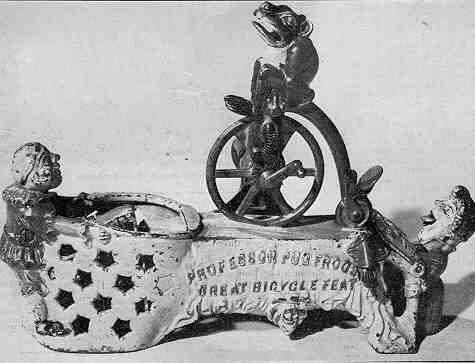Professor Pug Frog’s Great Bicycle Feat
by F.H. Griffith - HOBBIES Magazine - January, 1953

One of the more intriguing aspects of mechanical banks is the ingenious method of operation employed on certain of the banks whereby the coin is deposited mechanically while taking part in the action. Probably the outstanding example of this is Professor Pug Frogs Great Bicycle Feat. This feature, plus its extremely attractive appearance and desirability, rank it in the sixteenth position in our listing.
Other than the top few banks, there are no two specimens more desirable to have in a collection than Professor Pug Frog and The Girl Skipping Rope. This seems to have become a tradition in the lore of mechanical bank collecting, and deservedly so. Pug Frog, from a rarity standpoint, was apparently manufactured in fairly large quantities and a number of examples have survived through the years so it is not an extremely rare bank. It was very easily broken, however, due to its method of operation and finding one in good paint condition with no repairs is rather difficult.
Apparently the bank was never patented as so far no papers have turned up and there are no markings or dates any place on the bank. However, it’s definitely known the J. and E. Stevens Company of Cromwell, Connecticut, manufactured Professor Pug Frog and various features indicate that the designing work was done by Charles A. Bailey. The writer has in his possession an early Stevens catalog which features the bank on the cover. Judging from the contents of this catalog it dates in the late 1880’s or early 1890’s.
The specimen pictured is original throughout with no repairs and in nice paint condition with enough wear to indicate it was in a child’s possession.
Before describing the operation of the bank, there is a story of interest surrounding the placing of the coin on the bank so that it operates properly. Some years ago in the early collecting days it was generally taken for granted that the coin was placed in the mouth of the frog and it was supposed to drop from there into the basket held by the clown. This not only didn’t work but a number of banks were damaged this way. It was then thought, of course, that it was a poorly designed bank and certainly didn’t operate efficiently. The writer happened to be influential in discovering the fact that the coin should be placed over the rear wheel of the bicycle. When placed there the bank operated properly.
In operating this bank the crank located in the center of the large front wheel is given a few turns to wind up the spring. Then a coin is placed as described above and the protruding lever by the small rear wheel is pushed. Professor Pug Frog rides his bicycle in a complete circle fast as a wink returning to the original position. During the action the coin is thrown into the basket and the book held by the singing Mother Goose, on the right end of the bank, is pushed into her face causing her tongue to wag about. There is a clever double catch on the operating lever that always stops Pug Frog after one complete trip of the circular ride.
The bank is painted in bright attractive colors, the drapery in the center is white with red edging and the basket yellow. The figures are in red, blue and yellow costume and, of course, Pug Frog is green with a yellow throat and red mouth. The bicycle is aluminum color. The lettering of the name is painted in red and inscribed on the book are the words "Mother Goose Circus" painted in black.
Perhaps it might be well to explain what is meant by a coin being mechanically deposited while taking part in the action of the bank. In the case of Pug Frog the coin is thrown from the back of the bicycle into the basket when the bicycle revolves. Another example is Darktown Battery Bank where the pitcher throws the coin to the catcher. In both these banks the coin is part of the action and at the same time automatically deposited by the mechanism.
